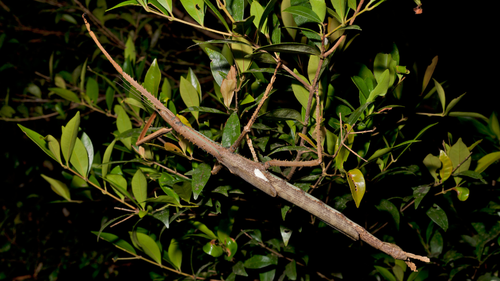<div class="block-content"><div class="styles__Container-sc-1ylecsg-0 goULFa"><span>A researcher has revealed how scientists made the discovery of a lifetime after identifying a new species of giant stick insect. </span></div></div><div class="block-content"><div class="styles__Container-sc-1ylecsg-0 goULFa"><span>The new species of stick insect called Acrophylla Alta measures in at 40cm long and weighs about the same as a golf ball, at 44 grams. </span></div></div><div class="block-content"><div class="styles__Container-sc-1ylecsg-0 goULFa"><span>James Cook University researcher Professor Angus Emmott helped identify the species and said the reason it hasn't been seen before is because it's habitat is too hard to access. </span></div></div><div><div id="adspot-mobile-medium"></div></div><div class="block-content"><div class="styles__Container-sc-1ylecsg-0 goULFa"><strong><span>READ MORE: </span></strong><a href="https://www.9news.com.au/national/sydney-news-supreme-court-to-hand-down-decision-on-harbour-bridge-protest/9f005f35-1c98-4e97-b71c-1eed2ceb4ed2"><strong><span>Supreme Court will not block Pro-Palestine protest on Harbour Bridge, judge says</span></strong></a><span></span></div></div><div class="block-content"><div class="styles__Container-sc-1ylecsg-0 goULFa"><span>"Being a very large insect, you would think it's very, very obvious (to spot)," Emmott said. </span></div></div><div class="block-content"><div class="styles__Container-sc-1ylecsg-0 goULFa"><span>"It lives in the southern part of the Atherton Tablelands, which is high-altitude rainforest. </span></div></div><div class="block-content"><div class="styles__Container-sc-1ylecsg-0 goULFa"><span>"It lives in areas up around 1000m and above, the other real reason people don't get to see it is that it actually lives right up in the canopy, so 20 metres to 40 metres up."</span></div></div><div><div class="OUTBRAIN" data-reactroot="" data-src="//www.9news.com.au/national/monster-stick-insect-found-in-queensland-identified-as-new-species/3c3c38b6-2680-4ad1-97f4-2f0ffd8a7437" data-widget-id="AR_5"></div></div><div class="block-content"><div class="styles__Container-sc-1ylecsg-0 goULFa"><span>"Unless you actually get a cyclone or a storm or a bird hits one, you don't see them down on the ground; people just don't get to see them." </span></div></div><div class="block-content"><div class="styles__Container-sc-1ylecsg-0 goULFa"><span>Emmot said researchers were "very excited" when they realised what they had found. </span></div></div><div class="block-content"><div class="styles__Container-sc-1ylecsg-0 goULFa"><strong><span>READ MORE: </span></strong><a href="https://www.9news.com.au/national/ebikes-and-escooters-could-be-banned-in-newly-proposed-law-due-to-growing-fire-risks/08e992cd-a507-4498-867e-ce1bacb76e6d"><strong><span>E-rideables may soon be illegal on public transport, Here are the current state laws</span></strong></a><strong></strong></div></div><div class="block-content"><div class="styles__Container-sc-1ylecsg-0 goULFa"><span>The professor explained how scientists were able to identify the massive insect as a new species.</span></div></div><div class="block-content"><div class="styles__Container-sc-1ylecsg-0 goULFa"><span>"You've got to look very closely; a lot of stick insects look fairly similar," Emmot said. </span></div></div><div class="block-content"><div class="styles__Container-sc-1ylecsg-0 goULFa"><span>"Right at the back of its body, it's got two little clasper-type things that you call cerci, and they're quite distinctive</span></div></div><div class="block-content"><div class="styles__Container-sc-1ylecsg-0 goULFa"><span>"The other thing that really helps is the eggs, every species of stick insect has different eggs, when you lay them all out side by side, you can clearly see the differences." </span></div></div><div class="block-content"><div class="styles__Container-sc-1ylecsg-0 goULFa"><span>"We got this one and he laid some eggs, we compared them, and it was very obvious that she was different apart from the other morphological.</span></div></div><div class="block-content"><div class="styles__Container-sc-1ylecsg-0 goULFa"><span>"We were pretty excited, we found this great big stick insect that's been hiding in plain sight."</span></div></div><div class="block-content"><div class="styles__Container-sc-1ylecsg-0 goULFa"><strong><span>READ MORE: </span></strong><a href="https://www.9news.com.au/national/homicide-investigation-in-country-victoria-after-woman-stabbed/eb91d72e-fab1-4ca9-b9c5-220a07714fdb" rel="" target="" title=""><strong><span>Homicide investigation in country Victoria after woman stabbed</span></strong></a><strong></strong></div></div><div class="block-content"><div class="styles__Container-sc-1ylecsg-0 goULFa"><span>Scientists think the insect's habitat could be the reason for its massive size.</span></div></div><div class="block-content"><div class="styles__Container-sc-1ylecsg-0 goULFa"><span>"It's a cool, wet environment where they live," he said.</span></div></div><div class="block-content"><div class="styles__Container-sc-1ylecsg-0 goULFa"><span>"Their body mass likely helps them survive the colder conditions, and that's why they've developed into this large insect over millions of years."</span></div></div>
Monster stick insect found in Queensland identified as new species

Leave A Reply
Your email address will not be published.*